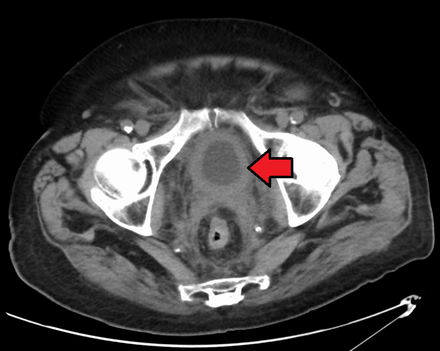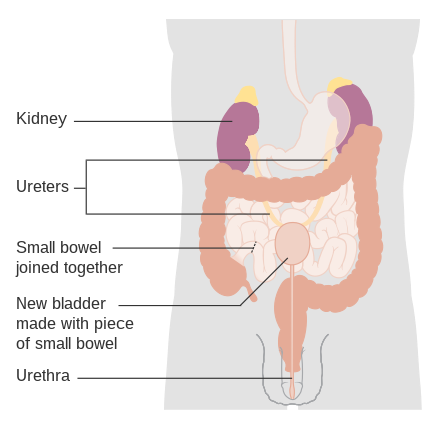Bladder Cancer
Bladder cancer arises from the tissues of the urinary bladder and is a significant concern in oncology and urology. It typically manifests between the ages of 65 and 84 and is more common in males. The primary types include transitional cell carcinoma, squamous cell carcinoma, and adenocarcinoma, with transitional cell carcinoma being the most prevalent.
Signs and Symptoms

Bladder cancer characteristically presents with blood in the urine (hematuria), which may be visible or microscopic. This symptom is typically painless and can be intermittent. Pain during urination, frequent urination, and a persistent urge to urinate are other potential symptoms, though they are not specific to bladder cancer. Advanced disease may present with pelvic or bony pain, lower-extremity swelling, or flank pain.
Causes
Smoking
Tobacco smoking is the primary known risk factor, accounting for over half of bladder cancer cases in men and a third in women. The risk increases with the duration and intensity of smoking. Quitting smoking reduces the risk but former smokers remain at a higher risk compared to never smokers.
Occupational Exposure
Occupational exposure to carcinogens such as benzidine, 4-aminobiphenyl, and others in industries like dye manufacturing, rubber, and leather work, also significantly increases the risk.
Infection
Infection with Schistosoma haematobium is a notable cause of bladder cancer, particularly squamous cell carcinoma. Chronic inflammation induced by the parasite’s eggs can lead to carcinogenesis.
Diet and Other Factors
High consumption of animal fat and dietary cholesterol increases risk in men. External beam radiotherapy for prostate cancer also raises the risk of developing invasive bladder cancer.
Diagnosis

Diagnosis primarily involves cystoscopy, where a cystoscope is used to inspect the bladder and obtain tissue biopsies. Transurethral resection of bladder tumour (TURBT) is very important for staging and determining treatment pathways. Imaging techniques like MRI and CT scans, along with urine cytology and various urine-bound markers, support diagnosis and staging.
Classification and Staging
Classification
Bladder cancers are classified based on histopathology into transitional cell carcinoma, squamous cell carcinoma, adenocarcinoma, and other less common types. Transitional cell carcinoma can further be subdivided based on cellular differentiation.
Staging

Bladder cancer staging follows the TNM system, considering tumour size (T), regional lymph node involvement (N), and distant metastasis (M). Tumours confined to the mucosa or invading the lamina propria are classified as Ta or T1, while those invading muscle are classified as T2, T3, or T4.
Treatment
Non-Muscle Invasive
Treatment for non-muscle invasive bladder cancer primarily involves TURBT, possibly followed by intravesical chemotherapy or immunotherapy. Bacillus Calmette–Guérin (BCG) therapy is a common immunotherapy used to prevent recurrence.

Muscle Invasive
For muscle invasive bladder cancer, treatment options include radical cystectomy (complete removal of the bladder), partial cystectomy, and urinary diversion. Neoadjuvant chemotherapy (before surgery) has shown a survival benefit. Chemoradiation (trimodal therapy) is an alternative for select patients.

Metastatic Disease
Metastatic bladder cancer is treated with cisplatin-based chemotherapy if the patient is fit for it. In cases where cisplatin is unsuitable, carboplatin-based regimens or immunotherapy with checkpoint inhibitors are used.
Prognosis
Prognosis depends on the stage at diagnosis. Non-muscle invasive cancers have a favourable outcome with a 5-year survival rate of 95%, while muscle invasive cancers have poorer outcomes. Advanced and metastatic bladder cancer has a median survival of 15 months with chemotherapy.
Self-assessment MCQs (single best answer)
Which age group is bladder cancer most commonly diagnosed in?
Which type of bladder cancer is the most prevalent?
What is the primary known risk factor for bladder cancer?
Which occupational exposure is NOT associated with an increased risk of bladder cancer?
What is the most common initial symptom of bladder cancer?
Which diagnostic procedure is primarily used to inspect the bladder for cancer and obtain tissue biopsies?
What does TURBT stand for?
What does the 'T' in the TNM staging system for bladder cancer refer to?
Which therapy is commonly used to prevent recurrence of non-muscle invasive bladder cancer?
What is the 5-year survival rate for non-muscle invasive bladder cancer?
Dentaljuce
Dentaljuce provides Enhanced Continuing Professional Development (CPD) with GDC-approved Certificates for dental professionals worldwide.
Founded in 2009 by the award-winning Masters team from the School of Dentistry at the University of Birmingham, Dentaljuce has established itself as the leading platform for online CPD.
With over 100 high-quality online courses available for a single annual membership fee, Dentaljuce offers comprehensive e-learning designed for busy dental professionals.
The courses cover a complete range of topics, from clinical skills to patient communication, and are suitable for dentists, nurses, hygienists, therapists, students, and practice managers.
Dentaljuce features Dr. Aiden, a dentally trained AI-powered personal tutor available 24/7 to assist with queries and provide guidance through complex topics, enhancing the learning experience.
Check out our range of courses, or sign up now!


